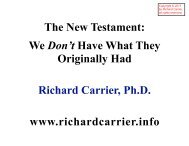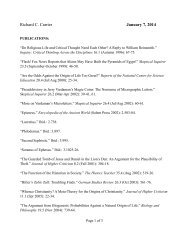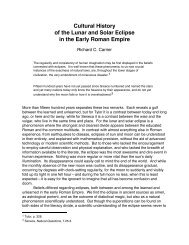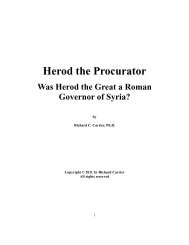“Bayes' Theorem for Beginners: Formal Logic and ... - Richard Carrier
“Bayes' Theorem for Beginners: Formal Logic and ... - Richard Carrier
“Bayes' Theorem for Beginners: Formal Logic and ... - Richard Carrier
Create successful ePaper yourself
Turn your PDF publications into a flip-book with our unique Google optimized e-Paper software.
28<br />
Defining the Hypothesis<br />
1. First you must define the hypothesis to be tested. In this case, the hypothesis being<br />
tested is the claim “The dog ate my homework” (in that specific context, from that<br />
specific student). There<strong>for</strong>e:<br />
h = “the dog ate the student’s homework”<br />
(= the student’s claim is true)<br />
2. Then define the negation of this hypothesis. This is what is the case if the hypothesis is<br />
false, which must be what would explain the same evidence if that hypothesis were false.<br />
There may of course be many alternative explanations. There are different ways to h<strong>and</strong>le<br />
that circumstance. We’ll bypass this by sticking with the artificial assumption that there is<br />
only one alternative:<br />
~h = “the student lied about the dog eating her homework”<br />
(= the student’s claim is false)<br />
3. Note that ~h could be generalized (to include all alternative explanations) as simply<br />
(<strong>and</strong> obviously) “The dog did not eat the student’s homework,” but as this includes no<br />
explicit explanation <strong>for</strong> any of the evidence (e.g. why the homework is missing, or how<br />
any other evidence came about that the student may have presented in support of his<br />
claim), it has limited explanatory value. This risks becoming a straw man. Specific<br />
theories of the evidence are more robust as explanations <strong>and</strong> thus pose a greater challenge<br />
to any hypothesis being tested. It is there<strong>for</strong>e always a good idea to think of what the<br />
most plausible alternative explanation of the evidence may be (or several, if there are<br />
several, <strong>and</strong>, say, rank them according to what you deem to be their relative plausibility).<br />
Determining Prior Probabilities<br />
1. The prior probability is a relative measure of what is typical. It is a measure of what is<br />
typical in that it draws on what you know about the world, the context, etc. (<strong>and</strong> students<br />
in general, this student in particular, etc.). It is a relative measure because its value is<br />
determined relative to all other explanations, <strong>and</strong> not in isolation from them. Thus, all<br />
possible explanations must be examined to determine the prior probability of any.








